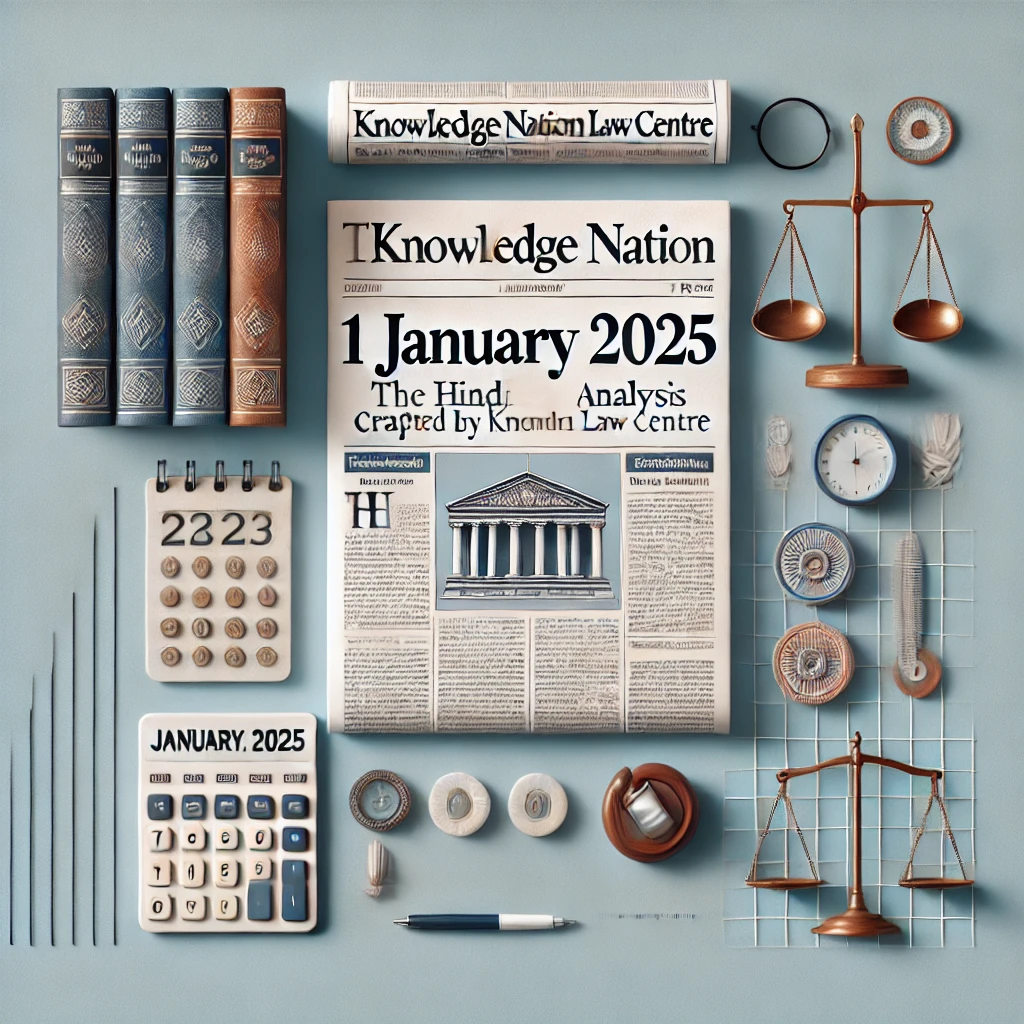01 January 2025: Daily The Hindu Analysis
Join WhatsApp community for Free Notifications, Updates, Study Material, Mock Tests, Internship Updates, and Current Affairs - CLICK HERE TO JOIN
1. The Nature of Dissent in the Indian Judiciary
(Source – The Hindu, International Edition – Page No. – 10)
Topic: Indian Polity – Judiciary
Context
- This article provides a comparative analysis of dissent within the U.S. Supreme Court and the Indian Supreme Court, highlighting the influences that shape these judicial dissents—political, social, and intellectual in nature.
Dissent in Democracies: A Comparative Overview:
Role of Dissent in Democracy
- Dissent is vital for a thriving democracy and plays a significant role within the judiciary.
- While powerful judicial dissents are present in both the Indian and U.S. Supreme Courts, the factors motivating these dissents vary across the two nations.
Dissents in the U.S. Supreme Court (SCOTUS)
Dissenting opinions in SCOTUS tend to be shaped by the political affiliations of the judges appointed to the court.
- For instance, Justice Stephen Breyer, chosen by Democratic leadership, has shown support for pro-affirmative action and anti-capital punishment views, particularly evident in his dissent during *Glossip v. Gross* (2015).
- Conversely, Justice Samuel Alito, appointed by Republicans, expressed opposition to same-sex marriage and abortion rights as illustrated in his dissent in *Obergefell v. Hodges* (2015).
To Enroll in Knowledge Nation Law Centre - Click Here
Political Dissent in the Indian Supreme Court
In contrast to the U.S. model, Indian judges are appointed by a collegium of senior judges, which mitigates the impact of political considerations on judicial outcomes.
- A notable example is the dissent of Justice H.R. Khanna in *ADM Jabalpur* (1976), where he opposed the suspension of fundamental rights during the Emergency, a viewpoint ultimately enshrined into law through a constitutional amendment.
- Another instance is during *P.V. Narasimha Rao* (1998), where Justices Agarwal and Anand voiced dissent regarding parliamentary immunity linked to bribery allegations, a position later contested in *Sita Soren* (2023).
Social Dissent in the Indian Supreme Court
- Judicial dissent can also reflect varied social perspectives on legal matters, particularly those concerning personal beliefs or religious practices.
- For example, in *Shayara Bano* (2017), Justices Khehar and Nazeer dissented from the majority ruling that invalidated the practice of triple talaq, arguing its significance within Sunni personal law.
- Additionally, in *Aishat Shifa* (2022), Justices Gupta and Dhulia provided differing opinions on whether the hijab ban in schools infringed upon secular principles.
Intellectual Dissent in the Indian Supreme Court
- Some dissents emerge from rigorous intellectual discourse on constitutional interpretation.
- For instance, in Lalta Prasad Vaish (2024), Justice Nagarathna dissented regarding the definition of “intoxicating liquor” in the Constitution, emphasizing the need for clarity in textual interpretation.
Conclusion
- Dissent is a fundamental mechanism for safeguarding judicial independence and shaping legal precedents within democracies.
It encourages a comprehensive engagement with legal doctrines and societal values.
Join WhatsApp community for Free Notifications, Updates, Study Material, Mock Tests, Internship Updates, and Current Affairs - CLICK HERE TO JOIN
2. Geopolitical Shifts in 2025: Opportunities and Challenges for India
(Source – Indian Express, Section – Explained- Page No. – 09)
Topic: International Relations
Context
- This article examines India’s geopolitical landscape in 2025, taking into account regional instability, global conflicts, and shifting alliances. It aims to highlight both the challenges and opportunities that lie ahead for India's foreign policy.
Analysis of the news:
A Dynamic Geopolitical Landscape in 2025
- The Quadrilateral Security Dialogue, commonly referred to as the Quad, comprises India, the United States, Australia, and Japan. Established in 2007, its initial purpose was to coordinate humanitarian assistance following the 2004 Indian Ocean earthquake and tsunami.
India’s Regional Neighborhood: Political Upheavals
- Bangladesh: he 16-year rule of Sheikh Hasina has ended amid protests, resulting in her exile to India. The interim government led by Muhammad Yunus is struggling with domestic unrest and strained relations with New Delhi over the issue of her extradition.
- Sri Lanka: The ascendance of leftist leader Anura Kumara Dissanayake introduces a new perspective, particularly regarding the aspirations of the Tamil minority, which will be closely monitored.
- Maldives: Under Mohamed Muizzu, relations with India have improved slightly, despite his initial anti-India rhetoric.
- Nepal: Concerns regarding K P Sharma Oli’s pro-China stance persist, although his alliance with the Nepali Congress may provide some stability.
To Enroll in Knowledge Nation Law Centre - Click Here
Global Conflicts and India’s Role
- Ukraine War: Ongoing peace negotiations are underway, with China and potentially India expected to play crucial roles. India must carefully evaluate its contributions and assess the risks associated with mediation efforts.
- China Relations: There are positive signs in border de-escalation talks, potentially leading to troop withdrawals in 2025. While trust issues remain, diplomatic initiatives, including a possible visit by PM Modi to China, could be instrumental in rebuilding ties.
- Pakistan: Relations remain stagnant, with New Delhi continuing to adopt a firm stance against engagement, primarily due to concerns over terrorism and limited prospects for the revival of SAARC.
Western Alliances: Opportunities and Challenges
- United States: The return of Donald Trump brings a layer of unpredictability, though a meeting between Modi and Trump could enhance bilateral relations.
- Canada: Diplomatic relations are strained due to allegations regarding India's involvement in the killing of a Khalistani separatist, complicating broader diplomatic interactions.
- Europe: The rise of far-right movements and ongoing immigration debates pose challenges for Indian students and professionals. Negotiations on free trade agreements with the EU and the UK continue amidst political uncertainties.
Engagement Beyond the West
- Africa: Renewed efforts for engagement could culminate in a summit, possibly hosted in Ethiopia, building on the success of the 2015 India-Africa Summit.
- Russia: President Putin’s visit to India and ongoing bilateral cooperation will be significant amid global scrutiny over the Ukraine war.
Conclusion: Balancing Promise and Peril
- The potential for renewed diplomatic engagement could culminate in a summit, possibly in Ethiopia, that seeks to advance the achievements of the 2015 India-Africa Summit.
- Additionally, President Putin's imminent visit to India and the ongoing bilateral cooperation between the two nations will play a critical role in the global discourse surrounding the ongoing Ukraine conflict.
Facts
1. Quad members commit to actively promoting a free, open, and stable Indo-Pacific region
(Source – The Hindu, International Edition – Page No. – 4)
Context
- During the recent meeting of Quad Foreign Ministers, participants reaffirmed their dedication to ensuring a free and open Indo-Pacific, highlighting the importance of ASEAN centrality and fostering regional cooperation.
To Enroll in Knowledge Nation Law Centre - Click Here
Quadrilateral Security Dialogue (Quad):
- The Quadrilateral Security Dialogue, commonly referred to as the Quad, comprises India, the United States, Australia, and Japan. Established in 2007, its initial purpose was to coordinate humanitarian assistance following the 2004 Indian Ocean earthquake and tsunami.
- The primary goal of the Quad is to promote an inclusive and open Indo-Pacific region. Key areas of collaboration include enhancing maritime security, advancing infrastructure development, improving connectivity, and addressing the challenges posed by China's expanding influence.
- Moreover, the Quad underscores the significance of the Association of Southeast Asian Nations (ASEAN) in ensuring regional security, as well as the role of the Pacific Islands Forum within the Pacific region. The upcoming Quad Summit is set to take place in India in the latter half of 2025, during which members will continue to support regional institutions such as the Indian Ocean Rim Association (IORA).
Join WhatsApp community for Free Notifications, Updates, Study Material, Mock Tests, Internship Updates, and Current Affairs - CLICK HERE TO JOIN
2. India-Nepal joint military exercise begins
(Source – The Hindu, International Edition – Page No. – 5)
Context
- The 18th iteration of Exercise Surya Kiran, a collaborative military training program between India and Nepal, has officially begun in the Shivalik ranges of Nepal.
To Enroll in Knowledge Nation Law Centre - Click Here
Exercise Surya Kiran:
- Overview of Exercise Surya Kiran: This exercise serves to enhance interoperability and foster greater collaboration between the armed forces of both nations. Conducted annually, it alternates location between India and Nepal. This year's exercises are taking place at the Nepal Army Battle School located in Saljhandi, within the Shivalik ranges of Western Nepal.
- Key Focus Areas: The primary emphasis of Exercise Surya Kiran lies in counter-terrorism operations, jungle warfare, and mountain warfare. Additionally, the program encompasses activities related to humanitarian assistance.
- Significance: Exercise Surya Kiran significantly reinforces the ties of friendship and military cooperation between India and Nepal.
Join WhatsApp community for Free Notifications, Updates, Study Material, Mock Tests, Internship Updates, and Current Affairs - CLICK HERE TO JOIN
3. 10 payloads of ISRO’s POEM-4 module deployed successfully
(Source – The Hindu, International Edition – Page No. – 6)
Context
- In a significant achievement, IN-SPACe has successfully operationalized 10 payloads on the POEM-4 module as part of the PSLV-C60/SpaDeX mission, catering to non-governmental entities.
POEM-4 module:
- The PSLV Orbital Experimental Module-4 (POEM-4) serves as a platform designed for conducting scientific experiments in the realm of space.
- Integrated into the PSLV-C60/SpaDeX mission, established by the Indian Space Research Organisation (ISRO), POEM-4 is composed of a repurposed PS4 stage from the PSLV rocket, utilized for deploying various payloads in orbit.
- It operates at an altitude of 350 km with a 55-degree inclination, thus providing a unique environment for experiments.
- Significantly, POEM-4 enables non-government entities, including startups, academic institutions, and research organizations, to validate space technologies without the necessity of launching entire satellites. This brings down the barriers for these entities to engage in space-related activities.
- IN-SPACE has effectively facilitated the establishment and operationalization of the 10 hosted payloads on the POEM-4 module.
To Enroll in Knowledge Nation Law Centre - Click Here
IN-SPACE stands for Indian National Space Promotion and Authorization Center.
- The Indian National Space Promotion and Authorization Center (IN-SPACe) is an autonomous body operating under the Department of Space. It is dedicated to the promotion of space activities by non-government entities.
- The agency encourages the participation of the private sector in India's space endeavors and aims to leverage Indian space infrastructure for such entities.
- It strives to create a level playing field for private companies within the space industry and is focused on fostering a vibrant and competitive space ecosystem in India.
Join WhatsApp community for Free Notifications, Updates, Study Material, Mock Tests, Internship Updates, and Current Affairs - CLICK HERE TO JOIN
4. Willow is a small chip for Google but a quantum leap for computing
(Source – The Hindu, International Edition – Page No. – 7)
Context
- Google has introduced its latest quantum chip, Willow, showcasing significant improvements in error correction and efficiency for addressing complex computational challenges.
What is Willow?
- Willow is a quantum processor created by Google, featuring 105 physical qubits dedicated to the storage and processing of information. This processor operates at exceptionally low temperatures, approaching absolute zero (-273°C). It incorporates both data qubits and measurement qubits to effectively manage errors during computation.
- Unlike classical computers, quantum systems like Willow leverage qubits, which possess the unique capability of representing both 0 and 1 simultaneously through the phenomenon of superposition. With advanced error-correction techniques, Willow demonstrates enhanced speed and reliability compared to its predecessors.
- Remarkably, Willow accomplished a complex task known as random circuit sampling in mere minutes—an operation that would require classical computers millions of years to complete. The potential applications for Willow are substantial, with possibilities in fields such as drug design, climate science, and optimization.
Join WhatsApp community for Free Notifications, Updates, Study Material, Mock Tests, Internship Updates, and Current Affairs - CLICK HERE TO JOIN
5. Social Inequality Linked to Accelerated Brain Aging and Dementia: Study
(Source – Indian Express, Section – Explained – Page No. – 09)
Context
- The recent study discussed in the article establishes a vital connection between social inequality and the aging of the brain, as well as the onset of dementia. It underscores the imperative of addressing socioeconomic disparities to enhance global outcomes in brain health.
Analysis of the news:
Link Between Social Inequality and Brain Health
- Research has identified a direct correlation between social inequality and age-related alterations in brain structure that are associated with dementia. With predictions indicating an increase in dementia cases—especially in low- and middle-income countries—this study stresses the necessity of tackling socioeconomic inequalities as a foundational component of brain health interventions.
To Enroll in Knowledge Nation Law Centre - Click Here
Study Scope and Methods
- Conducted by research teams from South America and Trinity College Dublin, the study involved an extensive analysis of over 2,100 individuals from Latin America and the United States, including participants affected by neurodegenerative diseases like Alzheimer’s. The researchers examined national indices of structural inequality to assess their influence on brain volume and connectivity, particularly in areas crucial for memory and cognitive function.
Key Findings: Impact of Inequality
- The study's findings indicate that heightened socioeconomic disparities correlate with diminished brain volume and connectivity, with the most significant effects evident in Latin America. Notably, Latino individuals with Alzheimer’s were found to suffer the most severe consequences, emphasizing the aggravation of neurodegeneration in contexts of high inequality. These associations remained significant even after accounting for individual factors such as education, age, and cognitive ability.
Macro-Level Determinants of Brain Health
- The research highlights the influence of macro-level social determinants, including structural inequality and the physical environment, on brain health, independent of individual characteristics. The authors advocate for integrating these broader factors into global strategies aimed at improving brain health.
Implications for Future Research
- The outcomes of this study open avenues for further investigation into the biological mechanisms that connect social inequality to neurodegeneration. There is an urgent need to incorporate macro-level social determinants into interventions aimed at mitigating disparities in brain health and aging outcomes on a global scale.

 Info@Knowledgenation.co.in
Info@Knowledgenation.co.in











Leave a Comment